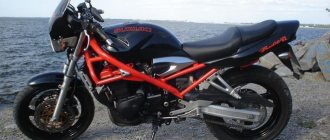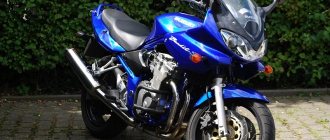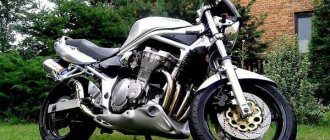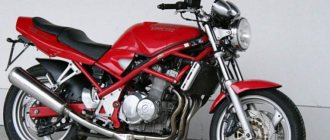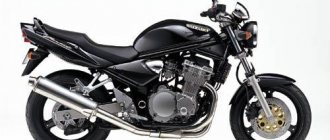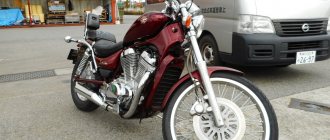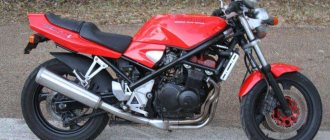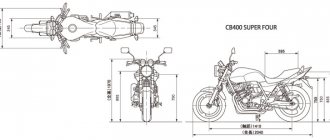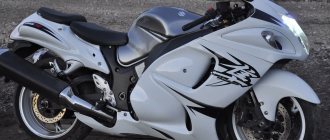The Suzuki GSF 250 motorcycle, the youngest representative of the “Bandits” line, is also one of the last representatives of the small-capacity class with 4-cylinder engines. Despite its impressive characteristics, it was after its production that the Suzuki company decided that other engines, with 1 or 2 cylinders, should be installed on small bikes in order to save money and increase service life. They don’t make motorcycles like this anymore, which is a pity... But this review of the 250 cc Bandit will reveal the strengths and weaknesses of this model.
Specifications
For its time, the bike was simply magnificent. In parallel with it, competitors from other brands were produced, so Suzuki could not afford to lose to them, and they did not save on the cost of the motorcycle. As a result, the Suzuki Bandit 250 has very impressive technical characteristics for a small-capacity vehicle.
Engine
Walk - just walk! Apparently, this is what Suzuki engineers said when they installed a 4-cylinder, 4-stroke liquid-cooled engine (and the “red-headed” modification even received a variable timing system). The results impressed everyone - acceleration to 100 km/h was 7 seconds , and maximum speed was as much as 180 km/h . The engine loves high speeds, and peak power is 45 hp. occurs at around 14,500 rpm , and the peak torque of 25 Nm is at 10,500 rpm . In the lower rev range, thrust is sluggish, a consequence of the small displacement of the Bandit 250 engine.
Transmission
Suzuki Bandit received a classic 6-speed gearbox with very short first gears. When driving dynamically, you can generally switch immediately from first to third, and from third to fifth - the bike reacts to this normally. The gearbox is reliable, and its settings are fully consistent with the technical characteristics of the motorcycle as a whole.
Chassis and brakes
The bike was based on a steel frame with a steel pendulum (later replaced by an aluminum one). The front telescopic fork has no adjustments, but the rear monoshock absorber has as many as 7 positions for preload . The brakes are mediocre, with a 2-piston caliper and 310mm disc at the front and a 250mm disc at the rear with the same caliper. The braking distance of the Suzuki Bandit 250 at maximum speed cannot be called short, so you need to drive carefully.
Electronics
The Suzuki Bandit does not have any complex electronic components. Transistor ignition, battery, analogue instrument panel - that's probably all.
Weight and dimensions
In terms of dimensions, the Bandit GSF 250 is comparable to any 400 of those years; it cannot be called too compact. But it was also created for the Japanese domestic market, and was designed for short, middle-sized Japanese, so it will be cramped for tall bikers. But it weighs a little, dry weight does not exceed 146 kg . Quite a lot for a small-capacity car, but the Suzuki Bandit was created three decades ago, and then technical progress had not yet advanced as far as it does today.
Controllability
Thanks to its modest weight, thoughtful weight distribution and overall successful design, the Bandit 250 motorcycle is very easy to control. But at first it will take some time to get used to its nervous character - the engine reacts sharply even to a slight turn of the throttle, especially at the bottom.
Fuel consumption
The officially declared fuel consumption is about 2 liters of AI-92 at a speed of 60 km/h. In real conditions, the motorcycle is voracious, and it consumes up to 6 liters of gasoline per 100 km , or even more.
Competitors Suzuki GSF250 Bandit
The main competitors in the motor market for the Bandit were and remain the Honda Hornet, Yamaha Zeal and Kawasaki Balius with similar engine sizes. What is the difference between them and why is the Suzuki Bandit considered one of the most successful models?
Kawasaki is not inferior to Suzuki in any respect and even surpasses it in speed. Excellent brakes and fast acceleration make it one of the best in handling and movement in high-speed traffic. A more rigid chassis allows you to ride calmly even on slightly rough terrain. Having such advantages, Kawasaki loses only in a big name. And if the “Bandit” has long become a legend and the talk of the town, the Kawasaki Balius cannot boast of such popularity.
But the Honda Hornet is a more modern representative of 250 cc motorcycles. A bright and stylish road motorcycle with bare-bones details is not inferior to the Bandit in design. The same cannot be said about the internal characteristics. The Honda has a 2-cylinder engine, which is inferior to the one installed in the Suzuki.
Yamaha Zeal has a sporty V-twin engine. Online reviews of him are mostly positive. Among the advantages over the Suzuki GSF250 Bandit are its low cost and low mileage. On the other hand, spare parts for this motorcycle are much less common than for the common Suzuki.
All models of advanced motorcycle concerns, presented with a volume of 250 cm3, have approximately the same technical characteristics. And here everyone chooses rather according to the appearance and condition of a particular motorcycle.
Repair and tuning
Trying to “shove in the impossible,” that is, to create a 250 with the capabilities of a 400, Suzuki engineers were forced to make a number of compromises. This affected the further service of the Bandit 250 and its price, which was quite high at the time of sales.
Repair
Thanks to its design simplicity, the Bandit 250 can be repaired and maintained on its own; there are no technological innovations in it. But its layout is very tight, and sometimes you simply cannot squeeze your hand with a screwdriver into the right place. Obviously, it was initially intended to use special tools from Suzuki, which would facilitate all these operations.
Spare parts
Many units come from Bandit 400, which was built on the same base, but with a number of differences. Original spare parts can still be bought, but they are often quite expensive, and maintaining the bike costs a pretty penny.
Tuning
There has been no official tuning for the Suzuki Bandit 250 for a long time. Almost everything that can be installed on it can be classified as a “universal” category - clip-ons, handlebars, grips, footpegs and other external body kit.
Motorcycle modifications
During the time it was produced, the Suzuki Bandit 250 did not experience major changes. There were versions with clip-ons and with a classic steering wheel, with and without a front fairing. In 1993, due to changes in Japanese laws, the power was reduced from 45 to 40 hp, and in 1995, production of the Suzuki Bandit 250 2 began. The appearance and dashboard were changed, and the steel pendulum was replaced with an alloy one. red-headed ” modification with the VC system began , and the volume of the gas tank increased from 14 to 15 liters .
Steering wheel design
At the beginning of 1996, the “two hundred and fiftieth” was returned to the assembly line, mass production was expanded, and the motorcycle was exported in large quantities. Production continued until 2002. In recent years of production, several restylings have been carried out. For example, the motorcycle was returned to clip-ons, with which production began in 1989, but which were later cancelled. For a road motorcycle, it doesn’t matter much how its handlebars are designed, whether it is solid or divided into two parts. Clip-ons are necessary for racing cars when certain adjustments to the handlebars are required to correct the rider's riding position. The ease of riding a road bike depends on a number of factors, but setting up a motorcycle is not difficult.
Advantages and disadvantages
The strengths and weaknesses of the Suzuki Bandit 250 directly stem from its class. Japanese engineers squeezed everything they could out of the small engine, achieving excellent results. But as a result, they received a motorcycle with a low resource and a unique character, which must be constantly kept in good shape for it to drive dynamically.
Advantages
- Decent acceleration dynamics . The Bandit 250 motorcycle can easily outshine almost all 250 cc bikes produced these days.
- High top speed . How many small-capacity cars do you know that can accelerate to 180 km/h?
- Compatibility of many spare parts that fit other Suzuki models.
Flaws
- The advanced age of all specimens. The model has been out of production for a long time, and finding an option that “stood in my grandfather’s garage for 20 years” is something of a fantasy.
- Lack of traction at the bottom . For dynamic driving, the engine must be turned mercilessly.
- Low resource . The piston engine is not designed for long mileage or long driving at maximum speed.
MotoForum.RU/Forum
Latest topics VIP announcements All novice bikers have questions - ask them here, and we will try to answer

